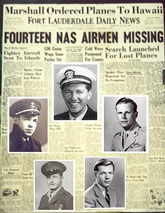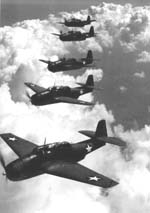Past
FLL was originally established as the Merle Fogg Field on May 1, 1929. Passenger traffic reached 134,733 in 1959 and topped one million travelers a decade later in 1969. The airport was named for a World War I aviator who moved to Fort Lauderdale in the 1920s to begin his own flying service. The airfield became Fort Lauderdale Naval Air Station (NAS) in 1942. During World War II, the U.S. Navy constructed three main runways and built a control tower as a training facility.
 Fort Lauderdale Daily News December 1945 | 
TBN Avengers circa 1945 |
In 1943, Ensign George H. W. Bush arrived at NAS Fort Lauderdale to train as a pilot. He would become the Navy’s youngest pilot and later the nation's 41st President.
In January 1948, Broward County assumed control of the facility, and in 1953, the county formally took ownership. Three years later, Mackey Airlines would introduce FLL's first scheduled airline service.
Present
In 2024, FLL welcomed 35.2 million passengers, up 0.3 percent from 2023. According to preliminary unofficial data from the trade group Airports Council International—North America, a notable authority in the aviation industry, the airport ranked in 2024 as the 19th busiest U.S. airport for passenger traffic overall, 20th for domestic travel volume, and 13th for international traffic. In 2024, FLL had an average of 337 daily departures, and its airline partners offered non-stop service to 97 U.S. cities and 55 international destinations in 25 countries. Before the COVID-19 pandemic, FLL generated $37.5 billion in economic activity annually and nearly 18,000 direct, local jobs.
Future
To meet the growing demand for the future, FLL is reimagining itself.
The airport’s newest Master Plan Update has been completed and outlines several key projects in the development pipeline, including a new Automated People Mover and Intermodal Center. The plan has identified future passenger demand and has outlined what changes and improvements are required to meet that growth for the next 30 years. Now finalized and approved by the Board of County Commissioners, Broward County’s economic powerhouse will continue to work on delivering an airport for the future while improving the overall guest experience. Read more about the Master Plan here.
In October 2019, the airport completed a four-month rehabilitation of its North Runway (10L-28R). Portions of the runway date back to 1943 when FLL was a Naval Training Base during World War II. In 2014, FLL completed the construction of a new South Runway (10R-28L).
The airport’s terminals and concourses have recently been completely remodeled, updated, or expanded as part of multimillion-dollar modernization projects that are winding down. New and exciting amenities were added to enhance the customer experience. Now located throughout the terminals are “Baby Oasis” lactation suites, pet relief areas, and 100 new restaurants and gift shops. New international passenger processing facilities have also been added to meet the rapidly growing increase in international passengers.
FLL's Notable Figures
Timeline of Important FLL Events
May 1, 1929 - Merle Fogg Airport dedicated.
June 3, 1942 - U.S. Navy commences construction on Naval Air Station (NAS) Fort Lauderdale.
October 7, 1942 - First Navy flight operations begin with the arrival of 17 TBN Avengers from Norfolk, VA.
June 1943 - George H. W. Bush begins training at the air station.
December 5, 1945 - Flight 19 disappears in the Atlantic Ocean - five aircraft and 14 crew members.
June 1, 1946 - NAS Fort Lauderdale decommissioned.
January 1948 - Broward County assumes control of the facility from the U.S. Navy.
View more important events in FLL's history.
Historic Milestones
75 years of bringing you closer to your world. Read an overview of important historical milestones (PDF) in the history of FLL.
